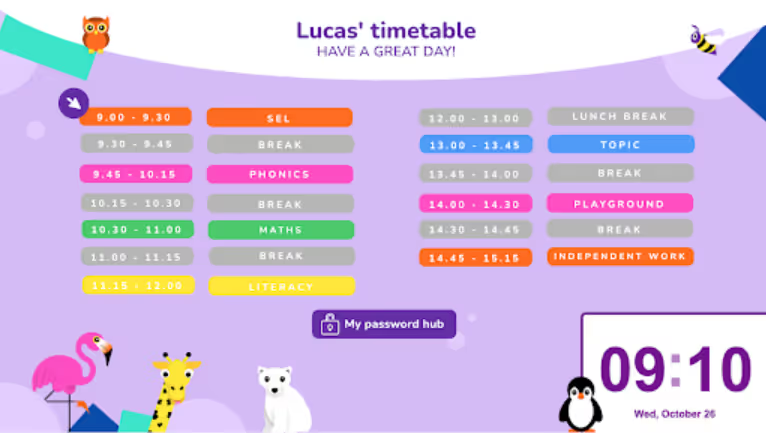Let’s be real — sending your kid to school from the living room raises a lot of questions.
Will they actually learn? Will they sit still? Will I have to become a part-time teacher to keep them on track?
These are all valid concerns. But the truth is, a good online homeschool program is designed to ease those worries, not add to them.
Here’s what to expect and what to look for, so you can figure out if online school is the right fit for your family.
Online homeschool programs offer structure and support, without leaving parents to do it all alone. Whether your kiddo is enrolled in a full-day online school like bina or using a mix of live and asynchronous lessons, these modern programs are no longer makeshift. They’re thoughtfully designed, effective, and flexible enough for learners of all ages. Even the little ones.
So, who thrives in this kind of learning environment?
If the phrase “homeschool program online” gives you flashbacks to pandemic chaos and kids upside-down on Zoom calls, take heart. Today’s programs are a different breed.
They’re structured, interactive, and designed to support both kids and parents. But you still probably have a few big questions.
Here are the most common concerns, answered.
Between meetings, laundry, and snack requests on loop, you need to know how school fits into your day, not take it over.
For younger kids, that usually means two to four hours of structured learning each day. But that doesn’t mean four hours glued to a screen. It’s a mix of live lessons, offline activities, and regular brain breaks.
That said, some online schools do offer a full-day structure. bina runs on a predictable 09.00 to 14.00 (9 AM to 2 PM) schedule (adjusted to fit multiple major time zones). This kind of routine works well for kids who thrive on consistency and need clear expectations for the day.
Instead of screen marathons, bina breaks the day into short, interactive sessions with plenty of movement, creativity, and offline time in between.
Another big question: Will my kiddo actually pay attention?
Thankfully, today’s programs are built with real attention spans in mind, not idealized ones. The goal isn’t just to keep them busy. It’s to keep them curious.
Here’s what makes a difference, in particular, how bina keeps kids engaged:
It’s a fun, low-pressure way for little learners to reset, reconnect, and recharge so they’re mentally and physically ready for their next lesson.
One of the biggest hesitations parents have about online school isn’t about academics — it’s about connection. Will my child still make friends? Will they get to talk to other kids, not just stare at a screen?
The short answer: yes, if you’re in the right program.
Strong online homeschool programs make peer interaction part of the daily experience, not just a bonus. That can include:
At bina, this is front and center. Students learn in tight-knit groups, guided by teachers who get to know each kiddo on a personal level. During lessons, they regularly break into pairs or groups to collaborate or join virtual clubs based on shared interests.
Kids work together in live classes, chat in small groups, team up on projects, and join virtual clubs based on shared interests.
And of course, you’re not limited to what the program offers. Many families layer in local homeschool co-ops, sports teams, or extracurriculars to round out their child’s social experience.
It’s easy to get swept up in the appeal of tech features and flexibility, but at the end of the day, you want to know your child is learning. Not just staying busy or checking boxes, but building real skills and making progress.
A strong online homeschool program should:
bina’s curriculum is globally aligned and designed for a world that’s anything but static. It blends UK standards with elements of the US Common Core, IB PYP, and the Australian curriculum, making it a great fit for kids growing up across countries or continents.
Not every kid fits neatly into a grade-level box. Some learn best by jumping in and trying things out, while others need time to observe and process before they’re ready to move on. And in a traditional classroom, that kind of flexibility can be hard to come by.
Many online homeschool programs offer flexible pacing, so that:
Some programs offer fully self-paced learning. Others, like bina, provide flexibility within a structured schedule. Teachers observe students daily through conversations, creative work, and collaborative tasks, then adapt lessons in real time. All kiddos can get what they need without being held back or left behind.
At bina, the school day is designed with balance and rhythm in mind — anchored by structure, but never overloaded with screens. Here’s what a typical day might look like for a six-year-old:

While the schedule runs from nine to two, it’s intentionally paced to support attention spans, creativity, and emotional well-being. Live sessions are short and interactive, with offline time built into every subject. The result is a school day that feels engaging, predictable, and developmentally appropriate.
Even with a great online program, your role as a parent is still important. But it doesn’t mean you need to hover over your child or become a full-time teacher. The key is staying connected, creating rhythm, and knowing when to step in (and when to step back).
Ask your child what they learned so you’re aware what topics they’re covering and where they are on their grade-level learning journey. Look at their projects, celebrate the little wins, and show genuine interest. When kids see that you’re invested, they stay more motivated, too.
Kids thrive on predictability. Whether your program has a full-day schedule like bina or a mix of live and flexible learning, build a rhythm that fits your family. Maybe that means breakfast together before class, a mid-morning stretch break, or reading time after lunch. Little anchors go a long way.
Online learning doesn’t mean sitting still all day. Use breaks for dance parties, backyard play, or a walk around the block. Movement helps with focus and mood.
Take advantage of social tools like virtual clubs, class discussions, or group projects. If possible, find local homeschool meetups, sports teams, or co-ops to round things out. Kids need both online and offline connections.
You're not in this alone. Programs like bina have teams (our Learning Success crew) dedicated to helping your child — and you — thrive. Reach out when you need ideas, support, or just someone to brainstorm with. That’s what they’re there for.
What if school could fit into your life, instead of the other way around? That’s the idea behind today’s best online homeschool programs. And bina takes it to the next level.
It’s not just about logging into Zoom and hoping for the best. At bina, kids get a real school experience: live classes, caring teachers, meaningful friendships, and a curriculum that connects to the world around them.
Here’s what makes bina stand out:
Whether you're traveling, living abroad, or just want something better than the usual school grind, bina gives your child the structure they need along with the freedom your family values.
It really depends on your child’s learning style and how hands-on you want to be. Some families love full-day programs with live classes and teacher support, like bina. Others prefer more flexible, self-paced options like Time4Learning.
Socialization can be tricky. Without planning, kids might miss out on peer interaction, group projects, or the day-to-day social learning that happens in traditional classrooms. Look for programs that offer built-in social time, or supplement with local activities or homeschool groups.
It can be a great option, especially for kids who need flexibility, fewer distractions, or a different pace. The key is finding a high-quality program that provides real structure, support, and connection, not just a list of assignments to complete alone.
Pick a program that fits your child’s needs, build a daily routine, and stay engaged with what they’re learning. Live classes, interactive projects, and regular feedback help kids stay interested and motivated, especially in the long run.
